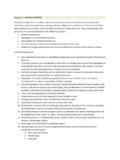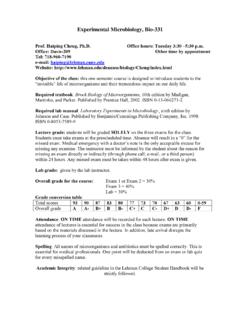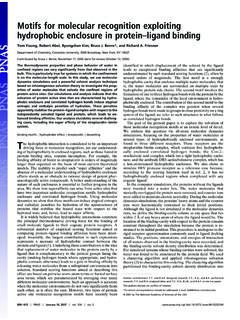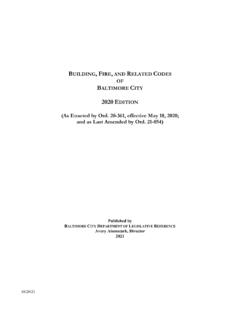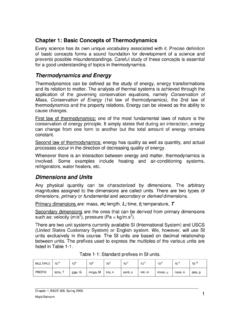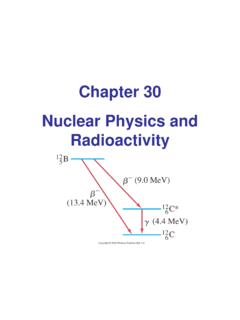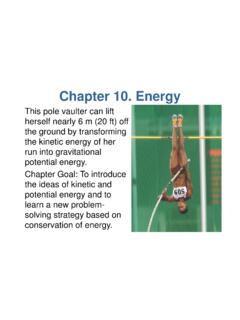Transcription of Chapter 24 Physical Pendulum
1 Chapter 24 Physical Pendulum Introduction .. 1 Simple Pendulum : Torque Approach .. 1 Physical Pendulum .. 2 Worked Examples .. 4 Example Oscillating Rod .. 4 Example Torsional Oscillator .. 7 Example Compound Physical Pendulum .. 9 Appendix 24A Higher-Order Corrections to the Period for Larger Amplitudes of a Simple Pendulum .. 12 24-1 Chapter 24 Physical Pendulum .. I had along with Descriptions, with some Drawings of the principal Parts of the Pendulum -Clock which I had made, and as also of them of my then intended Timekeeper for the Longitude at John Harrison Introduction We have already used Newton s Second Law or Conservation of energy to analyze systems like the spring-object system that oscillate.
2 We shall now use torque and the rotational equation of motion to study oscillating systems like pendulums and torsional springs. Simple Pendulum : Torque Approach Recall the simple Pendulum from Chapter coordinate system and force diagram for the simple Pendulum is shown in Figure (a) (b) Figure (a) Coordinate system and (b) torque diagram for simple Pendulum The torque about the pivot point P is given by P= rP,m m g=l r mg(cos r sin )= lmgsin k ( ) The z-component of the torque about point P ( P)z= mglsin . ( ) 1 J. Harrison, A Description Concerning Such Mechanisms as will Afford a Nice, or True Mensuration of Time;..(London, 1775), 24-2 When >0, ( P)z<0 and the torque about P is directed in the negative k-direction (into the plane of Figure ) when <0, ( P)z>0 and the torque about P is directed in the positive k-direction (out of the plane of Figure ).
3 The moment of inertia of a point mass about the pivot point P is IP=ml2. The rotational equation of motion is then ( P)z=IP z IPd2 dt2 mglsin =ml2d2 dt2. ( ) Thus we have 22sindgdtl = , ( ) agreeing with Eq. 23. When the angle of oscillation is small, we may use the small angle approximation sin , ( ) and Eq. ( ) reduces to the simple harmonic oscillator equation 22dgdtl . ( ) We have already studied the solutions to this equation in Chapter A procedure for determining the period when the small angle approximation does not hold is given in Appendix 24A. Physical Pendulum A Physical Pendulum consists of a rigid body that undergoes fixed axis rotation about a fixed point S (Figure ).
4 Figure Physical Pendulum 24-3 The gravitational force acts at the center of mass of the Physical Pendulum . Denote the distance of the center of mass to the pivot point S by cml. The torque analysis is nearly identical to the simple Pendulum . The torque about the pivot point S is given by S= rS,cm m g=lcm r mg(cos r sin )= lcmmgsin k. ( ) Following the same steps that led from Equation ( ) to Equation ( ), the rotational equation for the Physical Pendulum is mglcmsin =ISd2 dt2, ( ) where IS the moment of inertia about the pivot point S. As with the simple Pendulum , for small angles sin , Equation ( ) reduces to the simple harmonic oscillator equation d2 dt2 mglcmIS . ( ) The equation for the angle (t) is given by (t)=Acos( 0t)+Bsin( 0t), ( ) where the angular frequency is given by 0 mglcmIS( Physical Pendulum ), ( ) and the period is T=2 0 2 ISmglcm( Physical Pendulum ).
5 ( ) Substitute the parallel axis theorem, IS=mlcm2+Icm, into Eq. ( ) with the result that T 2 lcmg+Icmmglcm( Physical Pendulum ). ( ) Thus, if the object is small in the sense that Icm<<mlcm2, the expressions for the Physical Pendulum reduce to those for the simple Pendulum . The z-component of the angular velocity is given by 24-4 z(t)=d dt(t)= 0 Asin( 0t)+ 0 Bcos( 0t). ( ) The coefficients A and B can be determined form the initial conditions by setting t=0 in Eqs. ( ) and ( ) resulting in the conditions that A= (t=0) 0B= z(t=0) 0 z,0 0. ( ) Therefore the equations for the angle (t) and z(t)=d dt(t) are given by (t)= 0cos( 0t)+ z,0 0sin( 0t), ( ) z(t)=d dt(t)= 0 0sin( 0t)+ z,0cos( 0t).
6 ( ) Worked Examples Example Oscillating Rod A Physical Pendulum consists of a uniform rod of length d and mass m pivoted at one end. The Pendulum is initially displaced to one side by a small angle 0 and released from rest with 0<<1. Find the period of the Pendulum . Determine the period of the Pendulum using (a) the torque method and (b) the energy method. Figure Oscillating rod (a) Torque Method: with our choice of rotational coordinate system the angular acceleration is given by 24-5 =d2 dt2 k. ( ) The force diagram on the Pendulum is shown in Figure In particular, there is an unknown pivot force and the gravitational force acts at the center of mass of the rod.
7 Figure Free-body force diagram on rod The torque about the pivot point P is given by P= rP,cm m g. ( ) The rod is uniform, therefore the center of mass is a distance d/2 from the pivot point. The gravitational force acts at the center of mass, so the torque about the pivot point P is given by P=(d/2) r mg( sin +cos r)= (d/2)mgsin k. ( ) The rotational equation of motion about P is then P=IP . ( ) Substituting Eqs. ( ) and ( ) into Eq. ( ) yields (d/2)mgsin k=IPd2 dt2 k. ( ) When the angle of oscillation is small, we may use the small angle approximation sin , then Eq. ( ) becomes 24-6 d2 dt2+(d/2)mgIP 0, ( ) which is a simple harmonic oscillator equation. The angular frequency of small oscillations for the Pendulum is 0 (d/2)mgIP.
8 ( ) The moment of inertia of a rod about the end point P is IP=(1/3)md2 therefore the angular frequency is 0 (d/2)mg(1/3)md2=(3/2)gd ( ) with period T=2 0 2 23dg. ( ) (b) energy Method: Take the zero point of gravitational potential energy to be the point where the center of mass of the Pendulum is at its lowest point (Figure ), that is, =0. Figure energy diagram for rod When the Pendulum is at an angle the potential energy is U=mgd2(1 cos ). ( ) The kinetic energy of rotation about the pivot point is 24-7 Krot=12Ip z2. ( ) The mechanical energy is then E=U+Krot=mgd21 cos ()+12Ip z2, ( ) with 2(1/3)PImd=. There are no non-conservative forces acting (by assumption), so the mechanical energy is constant, and therefore the time derivative of energy is zero, 0=dEdt=mgd2sin d dt+Ip zd zdt.
9 ( ) Recall that z=d /dt and z=d z/dt=d2 /dt2, so Eq. ( ) becomes 0= zmgd2sin +Ipd2 dt2 . ( ) There are two solutions, z=0, in which case the rod remains at the bottom of the swing, 0=mgd2sin +Ipd2 dt2. ( ) Using the small angle approximation, we obtain the simple harmonic oscillator equation (Eq. ( )) d2 dt2+mg(d/2)Ip 0. ( ) Example Torsional Oscillator A disk with moment of inertia about the center of mass Icm rotates in a horizontal plane. It is suspended by a thin, massless rod. If the disk is rotated away from its equilibrium position by an angle , the rod exerts a restoring torque about the center of the disk with magnitude given by cm=b (Figure ), where b is a positive constant.
10 At 0t=, the disk is released from rest at an angular displacement of 0 . Find the subsequent time dependence of the angular displacement ()t . 24-8 Figure Example with exaggerated angle Solution: Choose a coordinate system such that k is pointing upwards (Figure ), then the angular acceleration is given by =d2 dt2 k. ( ) The torque about the center of mass is given in the statement of the problem as a restoring torque, therefore cm= b k. ( ) The z-component of the rotational equation of motion is b =Icmd2 dt2. ( ) This is a simple harmonic oscillator equation with solution (t)=Acos( 0t)+Bsin( 0t) ( ) where the angular frequency of oscillation is given by 0=b/Icm.


